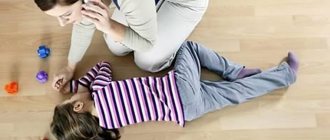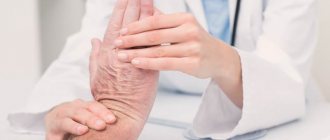What is vasovagal syncope
A short-term loss of consciousness with vasovagal syncope occurs when a person takes an upright position. Such phenomena occur due to stimulation of the vagus nerve, which innervates the chest, neck and intestines.
Vasovagal syncope occurs when a person is in an upright position at a time when, due to stimulation of the vagus nerve, the lumen of the blood vessels dilates and the pulse rate decreases.
The cause is usually stress, severe emotional shock, hunger, and external influences.
For differential diagnosis of serious diseases, a comprehensive examination is carried out, including 24-hour monitoring of heart function.
Treatment is aimed at combating the cause of fainting.
Like other types of fainting, vasovagal fainting develops against the background of a sharp decrease in blood flow to the brain due to the influence of a number of provoking factors: stress, nervous tension, fear, and others.
Loss of consciousness occurs due to the fact that the described processes contribute to the dilation of blood vessels, which leads to a decrease in blood pressure and heart rate (bradycardia). As a result, the brain experiences oxygen starvation.
If you notice symptoms of impending vasovagal syncope, you should lie down and loosen tight clothes, a tie, or a belt.
In most cases, the person immediately feels better. To speed up recovery, you can raise your legs above your head.
Neurologist, reflexologist, hirudotherapist
Kislitsyna Ekaterina Nikolaevna
10 years of experience
First aid for fainting
If the patient is feeling faint or has already lost consciousness, he should be placed on a horizontal surface, his clothes unbuttoned or removed - they restrict his breathing - and his legs should be placed on a hill to ensure blood flow to the head. In most cases, such help allows a person to quickly recover.
But it also happens that he continues to be in an unconscious state. In this case, it is necessary to give the brain some signal from the outside world so that it reacts and launches the entire “system”. This requires any strong stimulus. For example, you can give him ammonia to sniff, splash his face with cold water, or lightly pat his cheeks.
The patient should not be allowed to get up immediately after vasovagal syncope has occurred, since the blood supply has not yet been fully restored. It is necessary to bring him to his senses gradually, controlling his condition as far as possible. If such methods do not help, you should urgently call an ambulance, since prolonged brain hypoxia can cause irreversible changes, even death.
Kinds
In medicine, it is customary to divide vasovagal syncope into two types.
Classical
Loss of consciousness is accompanied by phenomena characteristic of other types of fainting states. Most often, the classic type occurs against the background of emotional disturbances (fear, strong emotions, etc.), or prolonged stay in an upright position. It is detected mainly in young people under 30 years of age.
Non-classical
This type of vasovagal syncope is diagnosed in cases where it is impossible to determine the provoking factor. Loss of consciousness in this scenario occurs mainly in older people.
Introduction
Fainting —also known as syncope —is the medical term for temporary loss of consciousness. Any episode of syncope is important for at least two reasons. First , fainting can cause injury, so it's important to try to prevent it from happening again. And secondly , fainting can sometimes be a sign of a serious medical problem. Although there are different types of syncope and the causes that lead to it, the most common type of syncope is vasovagal syncope.
Causes
The main cause of vasovagal syncope is an abnormal reaction of the body to the influence of the external environment, which has a stimulating effect on the receptors of the autonomic nervous system. The latter is responsible for the functioning of internal organs.
Modern medicine has not fully elucidated the question of what changes in the body lead to loss of consciousness. Vasovagal syncope is thought to develop due to stimulation of the vagus nerve. This theory is supported by the fact that when such conditions occur, the heart rate decreases.
There is also an opinion that instantaneous inhibition of the sympathetic part of the nervous system, which regulates the autonomic system, can lead to loss of consciousness. This explains why blood vessels dilate during fainting.
Moreover, each of the processes described above is activated under the influence of one or more provoking factors:
- strong emotional stress arising from the sight of blood, due to fear, and so on;
- pain ;
- staying upright for a long period of time;
- abrupt cessation of physical exercise;
- wearing tight ties or collars;
- binge eating;
- long stay in a stuffy room, in a hot bath;
- dieting , fasting;
- abuse of bad habits;
- chronic state of fatigue;
- depression;
- heart pathologies;
- tumor formations.
People suffering from cardiovascular diseases are strongly advised not to stay in hot rooms or in direct sunlight for long periods of time. This situation contributes to impaired blood flow, resulting in changes in blood pressure.
Why can our articles be trusted?
We make health information clear, accessible and relevant.
- All articles are checked by practicing doctors.
- We take scientific literature and the latest research as a basis.
- We publish detailed articles that answer all questions.
Fainting due to prolonged fasting is caused by a lack of vitamins and microelements. The latter leads to a decrease in hemoglobin and blood sugar levels, resulting in a malfunction of internal systems.
Under the influence of stress of a different nature (physical and psycho-emotional), the body, trying to compensate for the lack of important elements, temporarily inhibits some of its functions.
Any bad habits negatively affect the condition of blood vessels, which increases the risk of malfunctions in the cardiovascular system. The result of such processes is vasovagal syncope. Similar phenomena occur with chronic lack of sleep and fatigue. In this case, fainting performs a compensatory function of the body, whose blood flow is disrupted.
Vasovagal syncope is only dangerous when there is a risk of injury to the head and limbs from a fall. In this case, sudden memory loss signals a malfunction in the functioning of the entire organism or its individual parts.
Neurocardiogenic (vasovagal) syncope
Patients suffering from episodic hypotension and bradycardia, as a rule, do not have organic cardiac pathology and have normal blood pressure (BP) and heart rate during interictal periods. It is assumed that the causes underlying these syndromes are associated with disorders of autonomic regulation, which are identified by special diagnostic methods. So-called simple or orthostatic fainting does not belong to the group of NCS, since their occurrence is explained by a short-term functional decrease in autonomic activity. In the general population, orthostatic syncope is quite common; perhaps all people have experienced such vasovagal attacks at least once throughout their lives, and in this case, simple syncope should not be considered a disease. In addition to “cardiovascular” syncope, the genesis of recurrent attacks of loss of consciousness can be explained by many other reasons. Among them are organic and functional diseases of the central nervous system (CNS), including space-occupying neoplasms, hemorrhagic and ischemic cerebrovascular accidents, epileptic and epileptimorphic seizures. The appearance of syncope can be caused by stenotic diseases of large vessels that take part in the blood supply to the brain (primarily the carotid artery basin), recurrent thromboembolism, endocrine diseases (for example, adrenal crises), “primary” disorders of conduction and heart rhythm, and finally, psychiatric diseases and various iatrogenic factors. Repeated episodes of syncope of unknown origin in the absence of visible organic pathology of the central nervous system and cardiovascular system today appear to be the most common and at the same time the most confusing and insufficiently studied problem of medical practice. This is caused by a huge number of reasons that can provoke attacks of loss of consciousness, the lack of highly informative diagnostic methods, difficulties in identifying etiological factors, and, consequently, the impossibility of adequate treatment of such patients. It is estimated that up to 3% of the adult population have recurrent syncope. When conducting targeted diagnostic studies in the general population, more than 60% of undiagnosed patients are identified [1]. There is also a certain lack of information and conservatism among doctors. In addition, the diagnosis of neurocardiogenic syncope still remains exclusive in many countries. The presented review is largely based on the materials of the third international symposium dedicated to the diagnosis and treatment of NCC, held in the USA in September 1996. Clinical characteristics of patients
The clinical picture of syncope with transient loss of consciousness in patients with NCS is presented in various forms, from “expanded” prolonged attacks, accompanied by severe injuries and reminiscent of classic Morgagni-Adams-Stokes attacks, to mild semi-fainting states. Transient cerebral hypoperfusion leading to loss of consciousness may be due to either severe bradycardia or peripheral vasodilation. However, in most cases there is a combination of these two factors. However, in patients with vasovagal syncope
(VS syndrome), as a rule, systemic hypotension predominates in the clinic, bradycardia may not be expressed or clinically less significant and joins hypotension secondary.
In patients with carotid sinus syndrome
(CS syndrome), in most cases the clinical picture is determined by transient disturbances in conduction and heart rhythm in the form of sinus bradycardia, prolonged periods of asystole, often with disturbances in atrioventricular conduction. In addition to the “classical” ECG picture, the literature [2] describes cases of CS syndrome in patients with a permanent form of atrial fibrillation. The clinical picture of vasovagal syncope in a young soldier was first described by T. Lewis in 1932 [3]. Patients describe their condition during fainting as an oncoming blurred vision, a feeling of lack of air and a desire to take a deep breath. Often there are difficult to describe unpleasant sensations of emptiness in the upper abdomen. With further loss of postural tone, collapse may develop. Fainting usually does not last long and stops in a horizontal position or sitting after 2 - 3 minutes. The so-called malignant vasovagal syncope in elderly patients looks completely different. They are characterized by frequently recurring, longer-lasting fainting spells and are accompanied by severe injuries sustained during falls. Along with hypotension, the clinical picture is explained by prolonged episodes of cardiac arrest. Some trigger mechanisms for VS syndrome are well known - the sight of blood, pain, excessive emotions, prolonged standing, especially in a stuffy room, etc. Patients, having realized this over time, try to avoid situations that lead to fainting. At the same time, loss of consciousness can occur without prodromal symptoms and in unpredictable situations. The prognosis for VS syndrome, especially at a young age, is relatively favorable, but in elderly patients with malignant vasovagal syncope, the prognosis is aggravated by severe injuries. Loss of consciousness in patients with CS syndrome usually occurs suddenly and can be very similar to Morgagni-Adams-Stokes attacks in sick sinus syndrome and atrioventricular block. A distinctive feature is usually the long duration of both the attack itself and the “recovery” period - when for several minutes after loss of consciousness the patient remains inhibited and poorly oriented in what is happening. These differences are associated with the vasodepressive component of NCS. Bradycardia in such patients may not be expressed or be absent at all; blood circulation to vital organs during syncope remains at a sufficient level, which determines the “softness” and longer duration of the loss attack. Among other differences, it should be noted that CS syndrome mainly occurs in patients over 40 years of age, with men getting sick 2 times more often than women. There are no statistically significant differences in VS syndrome either by gender or age, although malignant forms are more common in old age [4]. Issues of the epidemiology of NCC are covered very poorly in the press. In England and Italy [5], according to a retrospective analysis, about 35–40 primary patients with CS syndrome are identified annually per million population. It is noted that these figures are underestimated and the actual incidence of this disease in the general population is higher, which is primarily due to the rare use of special diagnostic techniques by doctors. The incidence of VS syndrome appears to be much higher, but it is difficult to objectively estimate even the approximate number of patients with vasovagal syndrome. In one study [6], which examined the causes of syncope in a large group of patients with a history of two or more episodes of loss of consciousness, in 28% the diagnosis was not verified using “traditional” diagnostic methods, including electrophysiological examination of the heart. In this group, using special diagnostic methods, 60% of patients were diagnosed with VS syndrome. According to other authors [5], malignant forms of VS syndrome occur 2 times more often than carotid sinus hypersensitivity.
Pathophysiology
The pathogenesis of NCC remains unclear and insufficiently studied [7]. In its most general form, the mechanism of loss of consciousness is associated with cerebral hypoperfusion, which occurs as a result of a complex of neurocirculatory disorders leading to a decrease in systemic vascular tone (vasodepressor component) and heart rate (cardioinhibitory component) when systemic blood pressure falls below the autoregulatory zone. However, there are reports [8] that when conducting a transcranial Doppler study at the time of syncope, in some patients, cranial hypoperfusion is explained by cerebrovascular spasm, while systemic blood pressure and heart rate (HR) do not change significantly (“normotensive” syncope). The insufficiency of the autonomic nervous system in the regulation of systemic blood pressure and heart rate can theoretically be explained by its disturbances at various levels. This may be a violation of the afferent flow, defects in the afferent input to the central nervous system, inadequate levels of neurohormonal factors, pathological efferent response, changes in the sensitivity of the central nervous system to peripheral and neurohumoral signals, etc. Normally, there are mechanisms for rapid adaptation of blood pressure and heart rate to positional changes in body position in order to maintain relatively constant level of blood supply to the brain. Arterial and cardiopulmonary baroreceptor reflexes take the greatest part in the rapid regulation of cardiac output and vascular tone. Less significant are osmotic mechanisms for controlling circulating blood volume, afferent flows from central and peripheral chemoreceptors sensitive to pO2, pCO2 and blood pH, the level of endogenous hormones and neurotransmitters, including catecholamines, acetylcholine, vasopressin, angiotensin, atrial natriuretic factor and vasoactive intestinal polypeptides. It is widely believed that afferent trigger signals can enter the central nervous system from various organs and systems, primarily from the heart, large vessels, gastrointestinal tract and bladder. The receptors of these organs are sensitive to mechanical, chemical and pain stimuli. The largest number of arterial baroreceptors is present in the aortic arch and carotid sinus. Normally, with an increase in blood pressure, the frequency of impulses from them increases, which leads to peripheral “sympathetic” vasodilation and “parasympathetic” bradycardia. A decrease in afferent flow occurs in response to a decrease in blood pressure, which causes vasoconstriction and tachycardia. The reflex arc of these reflexes passes through the vasomotor center of the medulla oblongata. Cardiopulmonary stretch receptors, located in the pulmonary vessels and heart, are sensitive to changes in filling pressure and regulate myocardial contractility. Thus, with a decrease in intracardiac pressure, afferent signals from these receptors through the vagus and medulla oblongata trigger sympathetic efferent activity and increase the strength of heart contractions. Pathological reflexes in patients with VS syndrome may involve ventricular mechanoreceptors and chemoreceptors of the coronary arteries [9]. Cardiac mechanoreceptors are located in the myocardium of the atria and ventricles; similar receptors are located in the carotid arteries and the aortic arch. Their afferent pathways pass through myelinated and unmyelinated fibers. “Atrial” myelinated fibers originate from several types of receptors located mainly in the area of the connection of the atria with the superior vena cava and pulmonary veins. These receptors are sensitive to changes in central volume. Ventricular receptors have mechanical and chemical sensitivity, their activity is directly related to the contractility of the heart. The afferent pathways from them are represented by unmyelinated C-fibers, passing mostly through the vagus. An increase in the intensity of afferent signals from ventricular mechanoreceptors may be a trigger mechanism for systemic vasodilation and bradycardia. Afferent pathways from the mechanoreceptors of the carotid artery pass along the IX and X pairs of cranial nerves. Their stimulation reduces the sympathetic and increases the parasympathetic effect on the cardiovascular system. The reasons why a normal reflex acquires pathological features remain unknown. Peripheral and central afferent signals converge in various regions of the central nervous system, including the hypothalamus and cerebellum. Afferent flow from cardiovascular baro- and chemoreceptors enters through the glossopharyngeal and vagal nerves into n. tractus solitarius of the spinal cord and into the paramedial reticular nuclei. Various humoral factors, acting on these nuclei and other parts of the central nervous system, can take part in vasovagal attacks. Thus, α-adrenergic agonists, serotonin, and some amino acids (glutamate) regulate sympathetic flow, in contrast, stimulation with β-adrenergic agonists causes a central hypertensive response. Direct stimulation of the hypothalamus causes vasoconstriction of the vessels of the skin, intestines and kidneys, and vasodilation of the vessels of skeletal muscles. The participation of the higher parts of the central nervous system in the occurrence of syncope in response to such emotional stimuli as fright, fear, etc. is also undeniable. The efferent response of the central nervous system in patients with NCS includes an increase in cardiovagal tone and arterial vasodilation. The efferent mechanisms of vasodilation of resistance vessels are the least understood. Apparently, the drop in postganglionic sympathetic tone of vascular smooth muscles is of decisive importance in the development of pathological vasodilation. It is very likely that there is a constitutional predisposition of some patients to syncope associated with spatial movements of the body. It is obvious that the movement of the blood volume necessary to ensure adequate perfusion of the brain during a sharp transition from a horizontal to a vertical position depends on many anatomical and physiological features of the body structure. The number and size of vessels, their elasticity, the level of average blood pressure and hydrostatic forces are important. Venous valves play an important role in maintaining adequate filling of the right ventricle of the heart, since a sharp decrease in intracardiac pressure can provoke pathological mechano- and baroreceptor reflexes.
Diagnostic methods
By definition, the diagnosis of CS syndrome can be established using a provocative test with carotid sinus massage. This is a well-known vegetative test, which is carried out through a 5-6 second massage of the sinocarotid zone with the patient in a supine position. The test is assessed as positive when ventricular asystole lasting more than 3 seconds or systolic pressure decreases below 50 mmHg. Art. With this research protocol, the test turns out to be informative in 26-41% of patients with syncope of unknown origin. At the same time, in the absence of clinical manifestations of CS syndrome in the subjects, the test turned out to be false positive in 10% of practically healthy people, in 17% of patients with hypertension and in 20% of patients with various diseases of the heart and internal organs [10]. According to the same authors, the use of a different research protocol allows increasing the sensitivity of the method to 49%, specificity to 96% with 100% reproducibility of results (the latter indicator is extremely important for selecting adequate treatment). Changes in the protocol concern increasing the duration of the test to 10 s or more, atropinization of the patient in order to identify the vasodepressor component. In addition, it is advisable to simultaneously perform a bilateral massage of the carotid sinus both with the patient lying and standing. To identify patients with VS syndrome, the clinic uses various provoking manipulations, such as eyeball massage, hyperventilation test, Weber and Valsalva maneuvers. However, all of these tests have low sensitivity, low reproducibility, and poorly correlate with clinical manifestations [11]. In the mid-80s, in order to identify pathological reactions of the autonomic nervous system to orthostatic stress, R. Kenny et al. [12] proposed a test with passive orthostasis - head-up tilt table testing, which is currently the “gold standard” in the diagnosis of patients with NCS. Much less often in the clinic, a test that creates negative pressure testing is used). The tilt test is the most commonly used method in studying the mechanisms of impaired autonomic regulation and the development of syncope in patients with NCS. In its simplest form, the tilt test involves changing the patient's body position from horizontal to vertical. In this case, under the influence of gravitational forces, blood is deposited in the lower part of the body, the filling pressure of the right parts of the heart decreases, which triggers a whole group of reflexes. Normally, this change in body position increases the sympathetic response with arteriolar vasoconstriction and increased myocardial contractility. In patients with NCS, cardiovagal tone increases and arteriolar vasodilation occurs, which can lead to sudden systemic hypotension and cardiac arrest with an attack of loss of consciousness. The test is performed using a table for conducting orthostatic tests, on which the patient is securely fixed with special devices. After 20-30 minutes of “adaptation” in a horizontal position, the head end of the table is raised. Then, within 30-45 minutes, under the control of blood pressure and pulse rate, the response of the cardiovascular system to “orthostatic stress” is determined. In this case, the vasodepressor component can be assessed by continuous (beat to beat) pressure monitoring based on the use of plethysmography. There are significant differences in testing protocols among different laboratories where such tests are performed. Firstly, this applies to the use of potentiating medications (isoproterenol, nitroglycerin, adenosine triphosphate, etc.), which, according to some authors, significantly reduce the specificity of the study. There is no consensus on the angle of the table “tilt” and the duration of the test. The test is performed at angles of elevation of the head of the table by 60 - 80 degrees, while the sensitivity and specificity of the study are inversely proportional to each other - with an increase in the angle of inclination, the sensitivity increases while the specificity decreases. Currently, the search for “NCS markers” is actively ongoing, which would allow the development of simpler and more informative diagnostic methods. Based on the concept of the participation of ventricular mechanoreceptors in the reflex arc of the NCS, such parameters of intracardiac hemodynamics as the dynamics of systolic pressure in the right ventricle, dP/dt, preejection interval are studied as diagnostic markers [13]. Of particular interest are ECG data characterizing changes in vegetative status - heart rate variability, dynamics of the QT interval and the relationship of these indicators with respiratory status, QT/RR indicator, etc. [14].
Classification
The NCS classification is based on the results of the tilt test [11]. Type 1 (mixed) includes patients in whom bradycardia of up to 40 beats per minute, lasting no more than 10 seconds, is recorded during the test. In this case, the development of fainting is preceded by hypotension (a decrease in systolic pressure below 80 mm Hg), and a decrease in heart rate is secondary. Type 2 A (cardioinhibitory) - a decrease in rhythm exceeds 40 per minute and lasts more than 10 seconds. Asystoles lasting more than 3 s are recorded. The development of bradycardia is preceded by a decrease in blood pressure. Type 2 B (cardioinhibitory) - patients classified as this type differ from the previous group in that their hypotension during fainting occurs simultaneously with or following a decrease in heart rate. Type 3 (vasodepressor) - fainting in patients in this group is associated with hypotonic reactions, when the rhythm frequency during fainting can increase or, in any case, decrease by no more than 10% of the initial value.
Treatment
Adequate treatment of patients with NCS presents known difficulties due to the heterogeneity of clinical forms and problems in assessing the effectiveness of the treatment. Patients with rare vasovagal syncope and identified trigger factors should be advised, if possible, to avoid situations that lead to syncope (syncope associated with increased intrathoracic pressure during heavy lifting, playing wind instruments, the sight of blood, etc.). In some cases, when the trigger mechanism for syncope is obvious (for example, gastrointestinal syncope during swallowing associated with a hiatal or hiatal hernia), treatment may be aimed at eliminating the pathology of the gastrointestinal tract. Patients with glossopharyngeal syncope when coughing and sneezing should be advised to take medications that depress the cough center. In more severe cases, drug therapy or implantation of an artificial pacemaker is necessary.
Drug therapy
Drug therapy is indicated for patients with a predominance of the vasodepressive component in the clinic. It can also be prescribed in combination treatment with permanent cardiac stimulation, if the latter does not completely eliminate the clinical manifestations of the disease. Due to the diversity of pathophysiological mechanisms of NCS, a wide range of pharmacological drugs affecting different levels of the autonomic nervous system have been tested in clinical settings. In this regard, it is most advisable to evaluate the effectiveness of treatment with a particular drug under the control of a tilt test, the results of which highly correlate with the natural course of the disease [12]. Most often, small doses of beta-blockers (atenolol 25 mg per day, metoprolol 25-50 mg twice a day) are used to prevent recurrent syncope in patients with NCS. Moreover, in older age groups their effectiveness is significantly higher than in younger patients [15]. In cases of existing contraindications to taking b-blockers, theophylline (depot preparations 200 mg 2 times a day) or ephedrine (25 - 50 mg twice a day) can be used [16]. If beta-blockers, which are the first-line drugs in the treatment of patients with NCS, are ineffective, medications from other groups are used. Vagolytic drugs include disopyramide and scopolamine. Disopyramide, which produces negative inotropic and anticholinergic effects, has a positive effect in doses of 150–250 mg 2–3 times a day [16, 17]. If disopyramide is ineffective, vasoconstrictor drugs such as midodrine, etilephrine can be prescribed [14]; serotonin reuptake inhibitors - sertraline hydrochloride at a dose of 50 mg per day [18] and methylphenidate at a dose of 10 mg 3 times a day [19].
Permanent pacing
The indication for permanent cardiac pacing is the predominance of a cardiodepressive component in the clinical picture in the form of severe bradycardia or asystole, which, along with hypotension, leads to loss of consciousness. In general, the effectiveness of this treatment method has been proven by numerous studies, primarily in patients with CS syndrome. However, keeping in mind that a significant proportion of patients with NCS are people under 50 years of age with a relatively favorable prognosis, the choice of a rational treatment method sometimes poses a significant problem for doctors. An argument in favor of choosing permanent cardiac pacing as a treatment method for patients with NCS is the high frequency of side effects with chronic anticholinergic therapy. In addition, in comparison with conservative management of the patient, implantation of an electrical pacemaker (pacemaker) is more economically justified [20]. According to the National Pacing Database of the United Kingdom and the Republic of Ireland [21], from 1990 to 1995, 2165 primary pacemaker implantations were performed in this region, of which patients with CS syndrome accounted for 3.2% in 1990, and in 1995 - already 6.4% (53.1% were traditional indications - sick sinus syndrome and atrioventricular conduction disorders). The average age of patients with CS syndrome who received pacemaker implantation ranged from 28 to 95 years (mean 75 ± 11 years). At the same time, in Newcastle (Royal Victoria Infirmary), where a group of doctors pays special attention to the diagnosis and treatment of VCS, out of 600 primary pacemaker implantations in 1995, 139 (23.2%) operations were performed for CS syndrome and malignant forms of vasovagal syndrome. According to the recommendations of the ACC/AHA (American College of Cardiology / American Heart Association), indications for implantation of a permanent pacemaker for various disorders of conduction and heart rhythm are divided into three classes: the first includes diseases in which constant cardiac pacing is absolutely necessary, the second includes diseases , in the treatment of which cardiac stimulation may be recommended, but various authors do not have a consensus on this matter. According to these guidelines [22], class 1 includes recurrent syncope associated with clear spontaneous events. Fainting is provoked by massage of the carotid sinus, causing asystole lasting more than 3 seconds in the absence of taking any medications that cause depression of the sinus node or atrioventricular conduction. Relative indications for pacemaker implantation are recurrent syncope without clear provoking factors in the presence of a hypersensitive cardioinhibitory response. As well as syncope associated with bradycardia and reproduced using a tilt test or other provoking techniques, in which a repeated provoking test against the background of a temporary pacemaker can establish the likely benefit of implanting a permanent pacemaker. In connection with the development of new implantable devices, the indications for permanent cardiac pacing for vasovagal syncope have expanded in recent years [14]. Thus, special diagnostic and treatment algorithms have been developed (rate-drop response pacing algorithm), which make it possible to identify a “non-physiological” slowdown in rhythm and effectively prevent syncope through frequent stimulation of 100 - 120 impulses per minute. Summarizing the results of numerous retrospective studies in recent years regarding optimal stimulation modes, we can draw the now generally accepted conclusion that in the treatment of patients with NCS it is necessary to avoid single-chamber stimulation modes, giving preference to sequential stimulation for at least two reasons. Firstly, single-chamber atrial stimulation in the AAI(R) mode is contraindicated due to the frequent development of transient atrioventricular block [7] and at the same time, isolated ventricular stimulation in the VVI(R) mode is significantly less effective in preventing repeated syncope during NCS.
Literature:
1. Grubb BP et al. Tilt table testing: concepts and limitations PACE. 1997;20:781-7. 2. Cicogna R. et al. Carotid sinus hypersensitivity and syndrome in patients with chronic atrial fibrillation. PACE 1994; 17;1635-40. 3. Lewis T. A lecture on vasovagal syncope and the carotid sinus mechanism: With comments on Gower's and Nothnagel's syndrome. BMJ 1932;1;873-6. 4. Fitzpatrick A, Sutton R. Tilting towards a diagnosis in unexplained recurrent syncope. Lancet 1989;1:658-60. 5. Sutton R., Petersen M. The clinical spectrum of neurocardiogenic syncope. J. Cardivasc. Electrophysiology 1995;569-76. 6. Fitzpatrick A. et al. The incidence of malignant vasovagal syndrome in patients with recurrent syncope. Eur. Heart J 1991;12:389-94. 7. Bendit D, Rimoul S, Asso A, et al. Pacing for carotid sinus syndrome and vasovagal syncope. New perspectives in cardiac pacing. St. Petersburg; Silvan 1995;31-45. 8. Grubb BP et al. Cerebral vasoconstriction during head-upright tilt-induced vasovagal syncope. Circulation 1991;84:1157-64. 9. Lurie K., Benditt D. Syncope and autonomic nervous system. J.Cardiovasc. Electrophysiology 1996;7:760-76. 10. Brignole M., Menozzi C. Methods other than tilt testing for diagnosing neurocardiogenic syncope. PACE 1997;20:806-09. 11. Samoil D, Grubb BP. Vasovagal syncope: Pathophysiology, diagnosis and therapeutic approach. Eur. J Pacing Electrophysiology 1992;4:234-41. 12. Kenny RA et al. Head up tilt: A useful test for investigating unexplained syncope. Lancet 1989;1:1352-5. 13. Petersen M. et al: Right ventricular pressure, dP/dt, end preejection interval during tilt induced vasovagal syncope. PACE 1997; 20: 806-9. 14. Benditt DG et al. A Synopsis: Neurocardiogenic Syncope, An International Symposium, 1996. PACE 1996;20:851-60. 15. Slotwiner DJ et al. Response of neurocardiac syncope to b-blocker therapy: Interaction between age and parasympathetic tone. PACE 1997;20:810-14. 16. Natale A. et al. Efficacy of different treatment strategies for neurocardiac syncope. PACE 1995;18:655-62. 17. Kelly PA. et al. Low dose disopyramide often fails to prevent neurogenic syncope during head-up tilt testing. PACE 1994;17:573-7. 18. Grubb BP. et al. The use of serotonin reuptake inhibitors for the treatment of recurrent syncope due to carotid sinus hypersensitivity unresponsive to dual chamber cardiac pacing. PACE 1994;17:1434-6. 19. Grubb BP. et al. The use of Methylphenidate in the treatment of refractory neurocardiogenic syncope. PACE 1996;19:836-40. 20. Sutton R. et al. The economics of treating vasovagal syncope. PACE 1997;20:849-50. 21. Dey A. et al. The impact of a dedicated “Syncope and Falls” clinic on pacing practice in Northeastern England. PACE 1997;20:815-17. 22. Griffin D. Indications for the use of implantable antiarrhythmic devices: comments on the 1991 report of the Joint Working Group of the American College of Cardiology and the American Heart Association. New perspectives in cardiac pacing. St. Petersburg; Silvan 1995;31-45.
Symptoms
The development of vasovagal syncope occurs in two stages. Initially, several symptoms appear at once, indicating an imminent loss of consciousness:
- sudden pallor of the skin;
- intense cold sweat;
- loss of strength, which is initially observed in the limbs and then spreads to the whole body;
- dizziness;
- noise in ears;
- disorders of the gastrointestinal tract;
- pain appearing in the chest area;
- feeling of rapid heartbeat;
- the occurrence of tunnel vision, in which a person sees only those objects that are located in front;
- increase or decrease in heart rate.
The second stage is characterized by a short-term loss of consciousness. For some people, the symptoms described above do not ultimately lead to fainting.
Fainting after exercise
There are situations where vasovagal syncope occurs after exercise. In this case, the provoking factors are: a tight collar, a sharp turn of the head, strong compression of the chest, pressure on the area of the carotid sinus.
Vasovagal syncope occurs in athletes in the following way:
- a sudden reflex expansion of peripheral vessels occurs, as a result of which cardiac output sharply decreases and cerebral hypoxia develops;
- There is a sudden reflex suppression of cardiac activity by the vagus nerve until the heart stops completely.
In the first case, ordinary fainting occurs, and in the second, blood circulation suddenly stops, which requires immediate medical attention.
Diagnostic methods
After vasovagal syncope occurs, it is recommended to seek medical help, as sudden loss of consciousness may indicate serious problems in the functioning of the internal systems. In particular, these can be cardiovascular pathologies and malignant neoplasms.
Causes of loss of consciousness with convulsions
Convulsive fainting is one of the most common pathological conditions.
In order to establish the true cause that led to loss of consciousness, the doctor carries out the following measures:
- Gathering information about the patient’s current condition and main symptoms. In terms of establishing the causes of fainting, it is important to identify the initial phenomena that preceded the loss of consciousness.
- Analysis of the patient's life. The doctor asks about the patient’s professional responsibilities, concomitant pathologies and medications he is taking.
- Collection of information about family pathologies. This stage is important, since it has been established that vasovagal syncope in approximately 30% of cases is due to a hereditary predisposition.
- External examination of the patient, during which the condition of the skin and breathing rate are assessed. Additionally, the doctor listens to the lungs and heart.
- General analysis .
- chemistry . It allows you to determine the level of cholesterol, sugar, potassium and other elements.
If the latest tests did not show any abnormalities, then other diagnostic measures are additionally carried out aimed at identifying concomitant pathologies or excluding them.
Electrocardiography
It is prescribed to assess the performance of the heart muscle.
24-hour Holter electrocardiogram monitoring (HMECG)
The procedure lasts from 24 to 72 hours, during which ECG readings are regularly analyzed. Particular attention is paid to the changes that occur in the electrocardiogram during fainting.
Echocardiography
Vasovagal syncope does not affect echocardiography readings. This procedure is performed to exclude cardiac pathologies.
Orthostatic test (title test)
It is this examination method that allows us to detect vasovagal syncope. During the procedure, which lasts no more than half an hour, the patient is placed on a special bed set at an angle of 60 degrees. The patient is connected to a device through which the work of the heart muscle is assessed.
Additionally, blood pressure indicators are measured. After loss of consciousness, there is a sharp decrease in blood pressure and a short-term stop of heart contractions (a pause occurs).
If necessary, an examination by a neurologist is carried out. Electroencephalography and MRI, respectively, can exclude the presence of epilepsy and tumor, which can also provoke loss of consciousness.
Drug treatment
If vasovagal syncope is diagnosed, treatment depends on the severity of the illness. In some cases, loss of consciousness occurs very often, and it also happens that fainting goes away on its own. Treatment is usually prescribed for those whose condition occurs so frequently that the person becomes unable to work.
Drug therapy includes the use of beta-blockers such as Atenol and Metoprolol. With the help of these drugs, the processes of myocardial contraction are reduced and excessive activation of cardiac mechanoreceptors is prevented.
Bradycardia is treated with M-anticholinergic drugs. These are mainly patches consisting of scopolamine. They should be used once within three days. To reduce the frequency of fainting, the doctor prescribes Disopyramide, which has M-anticholinergic and negative inotropic effects. Theophylline is used much less frequently.
If during the diagnosis serious disturbances in the functioning of the heart, a lack of microelements or a tumor were identified, then the doctor should prescribe treatment methods in accordance with these diseases.
Therapeutic measures
The treatment regimen for vasovagal syncope is determined based on the severity of the underlying disease. Therapeutic intervention is mainly used for patients who often experience short-term loss of consciousness.
In cases where the problem under consideration arises due to mental pathologies, the treatment regimen is determined depending on the status of the underlying disease.
Therapy for vasovagal syncope consists of several approaches.
Drug treatment
The patient is prescribed the following medications:
Self-medication is dangerous with complications!
Attention
Despite the fact that our articles are based on trusted sources and have been tested by practicing doctors, the same symptoms can be signs of different diseases, and the disease may not proceed according to the textbook.
Pros of seeing a doctor:
- Only a specialist will prescribe suitable medications.
- Recovery will be easier and faster.
- The doctor will monitor the course of the disease and help avoid complications.
find a doctor
Do not try to treat yourself - consult a specialist.
- Alpha adrenergic agonists. They contribute to the narrowing of blood vessels.
- Beta blockers. Such drugs block specific receptors in the body that are activated under the influence of stress hormones (adrenaline and norepinephrine).
- M-anticholinergics. Prescribed for the treatment of bradycardia.
Surgical intervention
Used in the presence of heart diseases and tumors. Surgical intervention, during which, if appropriate indications are available, a pacemaker is introduced, is carried out subject to the following conditions:
- age exceeds 40 years;
- vasovagal syncope occurs with regular frequency;
- absence of initial symptoms indicating imminent loss of consciousness;
- arrest was recorded .
Lifestyle change
You can prevent another loss of consciousness by following these recommendations:
- drink at least two liters of liquid per day;
- exclude heavy physical activity;
- avoid emotional stress;
- sleep at least eight hours a day;
- stop wearing tight underwear, replacing them with compression ones;
- regularly perform exercises aimed at strengthening your mental state.
Special isometric exercises are also used, through which you can increase blood pressure for a short period of time:
- Holding the ball in your hand, you need to squeeze your palm. The action promotes the outflow of venous blood.
- Hands clasp together and then forcefully pull in opposite directions.
- In a standing position, the legs are crossed, after which they must be tensed.
In case of sudden loss of consciousness, the person must be placed on his back with his legs raised above his head. This pose increases blood flow to the brain.
Vasovagal syncope is not dangerous to humans. It causes only two types of complications:
- injuries resulting from a fall;
- deterioration in quality of life in cases where fainting occurs frequently.
Preventive measures can help prevent another loss of consciousness.
Fainting during pregnancy
Vasovagal syncope sometimes occurs during pregnancy. The condition of a woman in an interesting position is often accompanied by general malaise and increased weakness, and this is associated with an increased load on the body. The appearance of fainting makes her very worried. They occur in the following cases:
- a sharp change in blood circulation;
- low blood sugar;
- sudden movements;
- heat and stuffiness;
- long and frequent lying on your back;
- toxicosis.
Frequent fainting is dangerous due to falling, so you should definitely inform your gynecologist about this.
Prevention measures
In order to prevent vasovagal fainting, first of all, it is necessary to avoid psycho-emotional stress. In particular, these include both conflict situations that can cause stress and prolonged stay in an upright position. At the same time, active outdoor activities are used as preventive measures to prevent loss of consciousness: walking, running, and so on.
You can also prevent the onset of another fainting spell:
- hardening or contrast shower (strengthens blood vessels);
- adherence to daily routine;
- duration is at least 8 hours;
- Regular consumption of herbal tea, red wine or coffee to restore blood pressure;
- drinking chamomile, lemon balm or St. John's wort tea, which has a positive effect on the nervous system.
Vasovagal syncope is not a dangerous phenomenon, which, however, may indicate serious pathologies: cardiovascular diseases, tumors. You can cope with such phenomena if you change your lifestyle.










